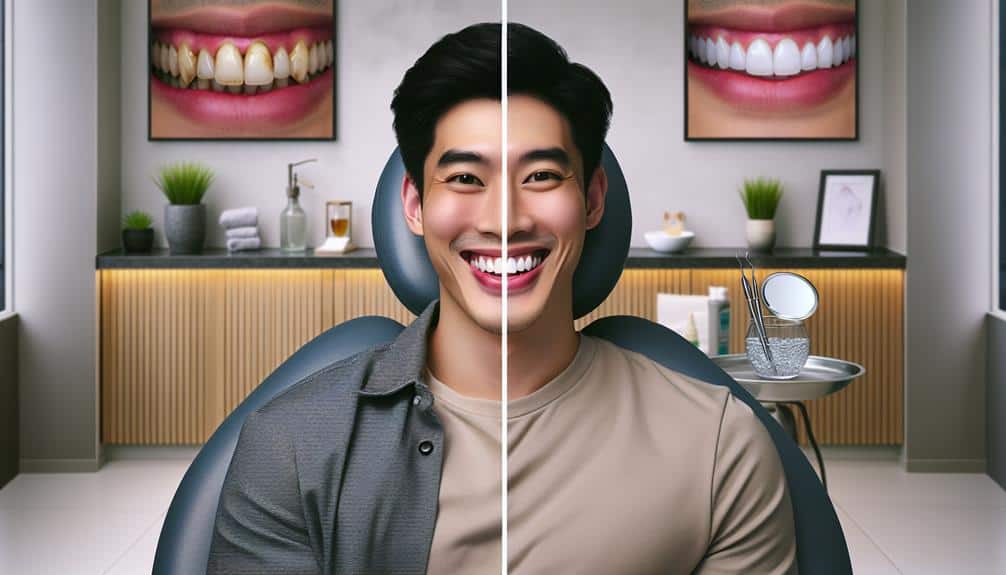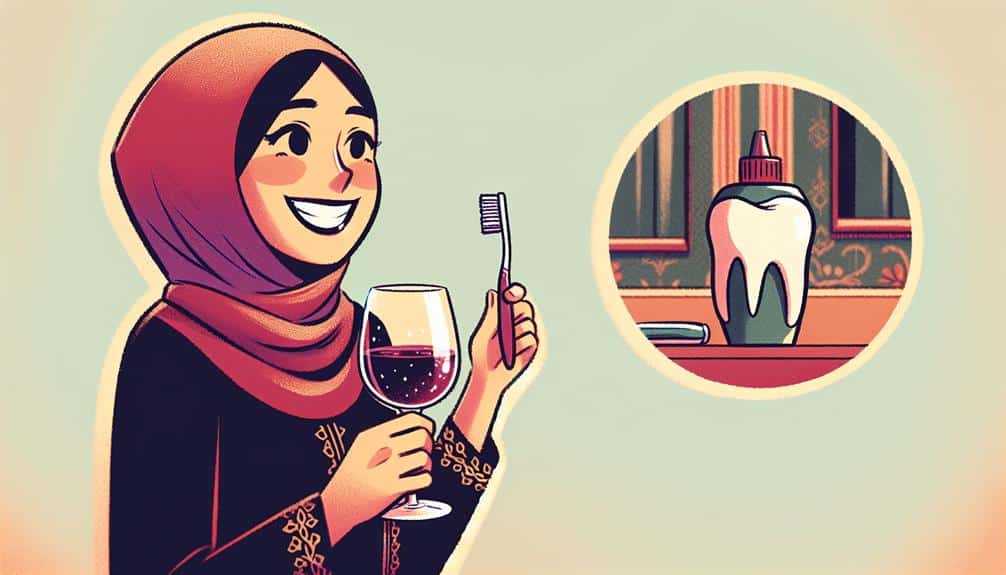Indulging in red wine, coffee, berries, and tomato sauce can lead to teeth staining. These foods contain pigments and compounds that can discolor your teeth over time. Consider pairing wine with aged cheeses rich in calcium to neutralize acids. Rinse your mouth with water after consuming berries to wash away pigments. Opt for a crisp salad before enjoying tomato sauce to help minimize its staining effects. Regular dental check-ups can address coffee-induced stains. Practical solutions exist to combat these effects and maintain a bright smile.
Key Points
- Red wine contains tannins that stain teeth; pair with aged cheeses to neutralize acids.
- Coffee and tea's pigments and tannins can lead to teeth discoloration.
- Berries like blueberries and blackberries have pigments that stick to teeth; rinse or consume with meals.
- Tomato sauce's lycopene and acidity can cause teeth staining; drink water and brush after consumption.
- Regular dental check-ups can prevent and address teeth stains caused by coffee and wine.
Red Wine
Indulging in red wine can lead to the staining of your teeth due to its high tannin content. Tannins are natural compounds found in grape skins, seeds, and stems, which can bind to the enamel of your teeth, causing discoloration over time. To prevent or minimize this staining effect, consider wine pairings that can help counteract the tannins. Foods like aged cheeses, which are rich in calcium, can help neutralize the acids in wine and reduce its staining potential on your teeth.
If you find your teeth stained from red wine, there are various stain removal techniques you can try. One method is to brush your teeth immediately after consuming red wine to prevent the tannins from setting in. Additionally, using a whitening toothpaste or undergoing professional teeth whitening treatments can help remove stubborn wine stains and restore the natural color of your teeth. Remember to consult with your dentist for personalized advice on maintaining a bright smile while enjoying your favorite red wines.
Coffee
To avoid potential teeth staining, be mindful of your coffee consumption as it can contribute to discoloration due to its high pigment content. Coffee is a beloved beverage but can lead to unsightly stains on your teeth. Here are some important points to keep in mind:
- Tea Stains: Similar to coffee, tea can also cause teeth staining due to its tannins and pigments. If you're concerned about maintaining a bright smile, limiting tea consumption or rinsing your mouth with water after drinking tea can help reduce staining.
- Smoking Effects: Smoking not only impacts your overall oral health but also plays a major role in teeth discoloration. The combination of nicotine and tar in cigarettes can lead to stubborn stains on your teeth. If you're a smoker, quitting or reducing smoking can improve the appearance of your teeth over time.
- Regular Dental Check-ups: Visiting your dentist regularly for cleanings and check-ups can help prevent and address coffee-induced teeth stains. Professional cleanings can remove surface stains and keep your smile bright and healthy.
Berries
Consuming berries regularly can contribute to teeth staining due to their vibrant pigments. Berries like blueberries, blackberries, and raspberries contain deeply pigmented compounds known as chromogens, which have the potential to stick to the enamel of your teeth, causing discoloration over time. When these pigments come into contact with your teeth, they can leave behind stains that may be challenging to remove.
To minimize the staining effects of berries, consider consuming them as part of a meal rather than as a standalone snack. This can help reduce the direct contact time between the pigments and your teeth. Additionally, rinsing your mouth with water after eating berries can help wash away some of the pigments before they have a chance to adhere to your teeth.
When enjoying berries in smoothies, consider using a straw to bypass direct contact with your teeth. For dessert pairings, opt for lighter-colored fruits or desserts to balance out the potential staining effects of berries. By being mindful of how you consume berries, you can still enjoy their delicious flavors without compromising the whiteness of your teeth.
Tomato Sauce
Tomato sauce, with its rich red hue and acidic nature, can be a culprit in causing teeth staining over time. The vibrant color of tomato pasta or spaghetti sauce comes from a pigment called lycopene, which has staining potential. Here are some reasons why tomato sauce can lead to wine-stained teeth:
- Acidity: Tomato sauce is acidic, which can erode the enamel of your teeth over time, making them more susceptible to staining.
- Pigmentation: The deep red color of tomato sauce contains chromogens, compounds known to discolor teeth when consumed frequently.
- Adherence: The thick consistency of tomato sauce allows it to cling to the surface of teeth, providing more time for its staining properties to take effect.
To minimize the impact of tomato sauce on your teeth, consider drinking water while eating to help wash away pigments, brushing your teeth after consuming tomato-based dishes, or enjoying a crisp salad before your main meal to create a protective barrier on your teeth.
Frequently Asked Questions
Are There Any Specific Toothpaste Brands or Products That Are Particularly Effective in Removing Wine Stains From Teeth?
For effective removal of wine stains from teeth, consider toothpaste brands with whitening properties. Whitening strips can also help. Mouthwash offers benefits, while proper flossing techniques aid in maintaining oral hygiene and reducing staining.
Can Drinking Water While Consuming Wine, Coffee, Berries, or Tomato Sauce Help Prevent Staining on Teeth?
Drinking water while enjoying wine, coffee, berries, or tomato sauce can help prevent teeth staining. Hydration maintains saliva production, aiding in washing away pigments. Consistent oral hygiene, like swishing water after eating staining foods, is key for preventive measures against discoloration.
How Long Does It Typically Take for Teeth to Become Stained From Consuming These Foods and Beverages?
Typically, teeth start to show staining from foods and drinks like wine, coffee, berries, or tomato sauce after consistent consumption over a few weeks. To prevent rapid stain progression, consider rinsing with water during and after consuming these items.
Are There Any Natural Remedies or Home Remedies That Can Help Remove Wine Stains From Teeth?
To remove wine stains from teeth, try natural and home remedies. Baking soda mixed with hydrogen peroxide can help. Brush gently and rinse. Strawberries and apple cider vinegar are also known to aid in stain removal.
Are There Any Specific Dental Procedures or Treatments That Can Help Eliminate Stubborn Stains Caused by These Foods and Beverages?
For those seeking to eliminate stubborn stains caused by foods and beverages, dental whitening treatments offer effective solutions. Professional dental cleanings can also help maintain a bright smile by removing surface stains and promoting oral health.



